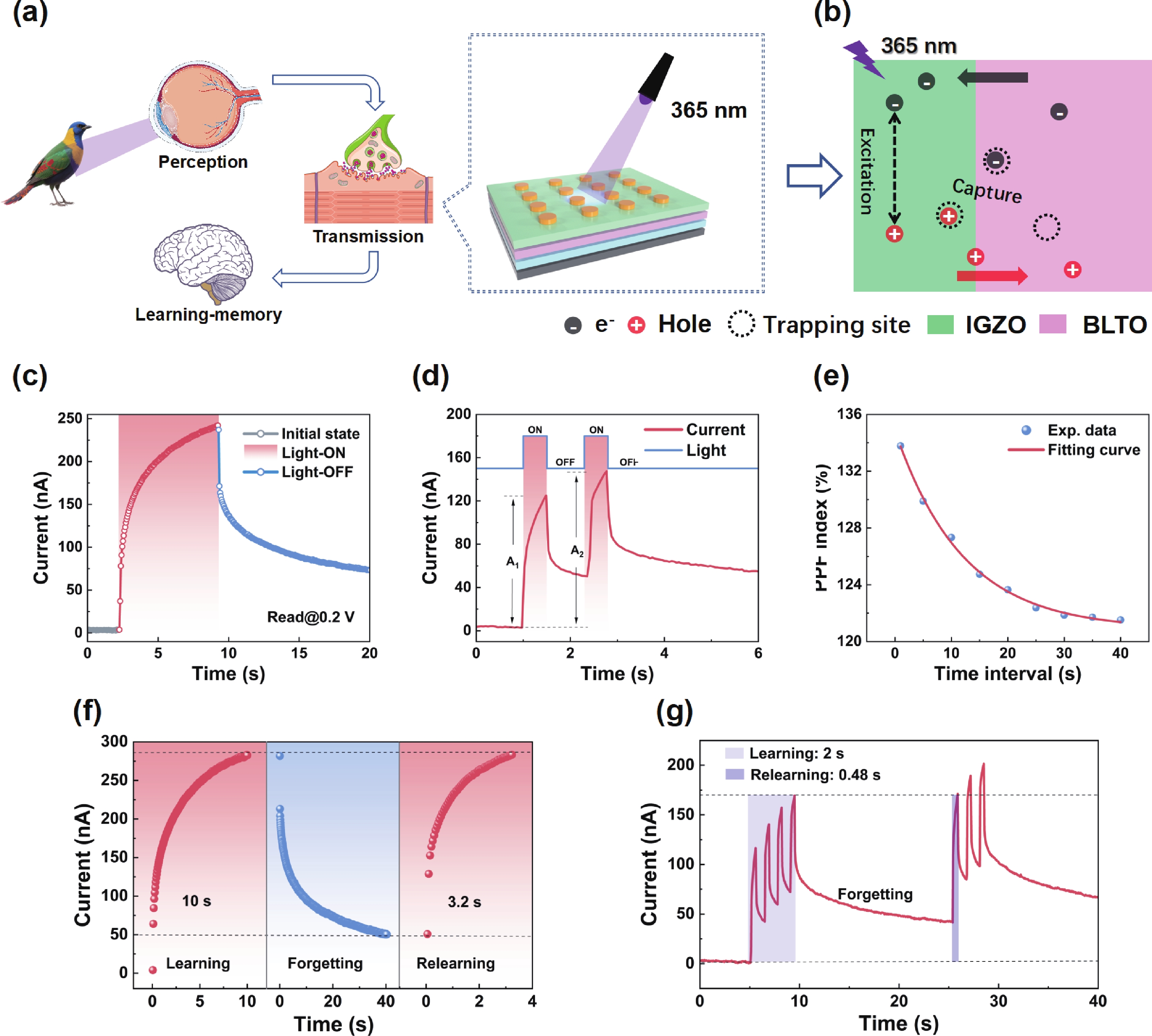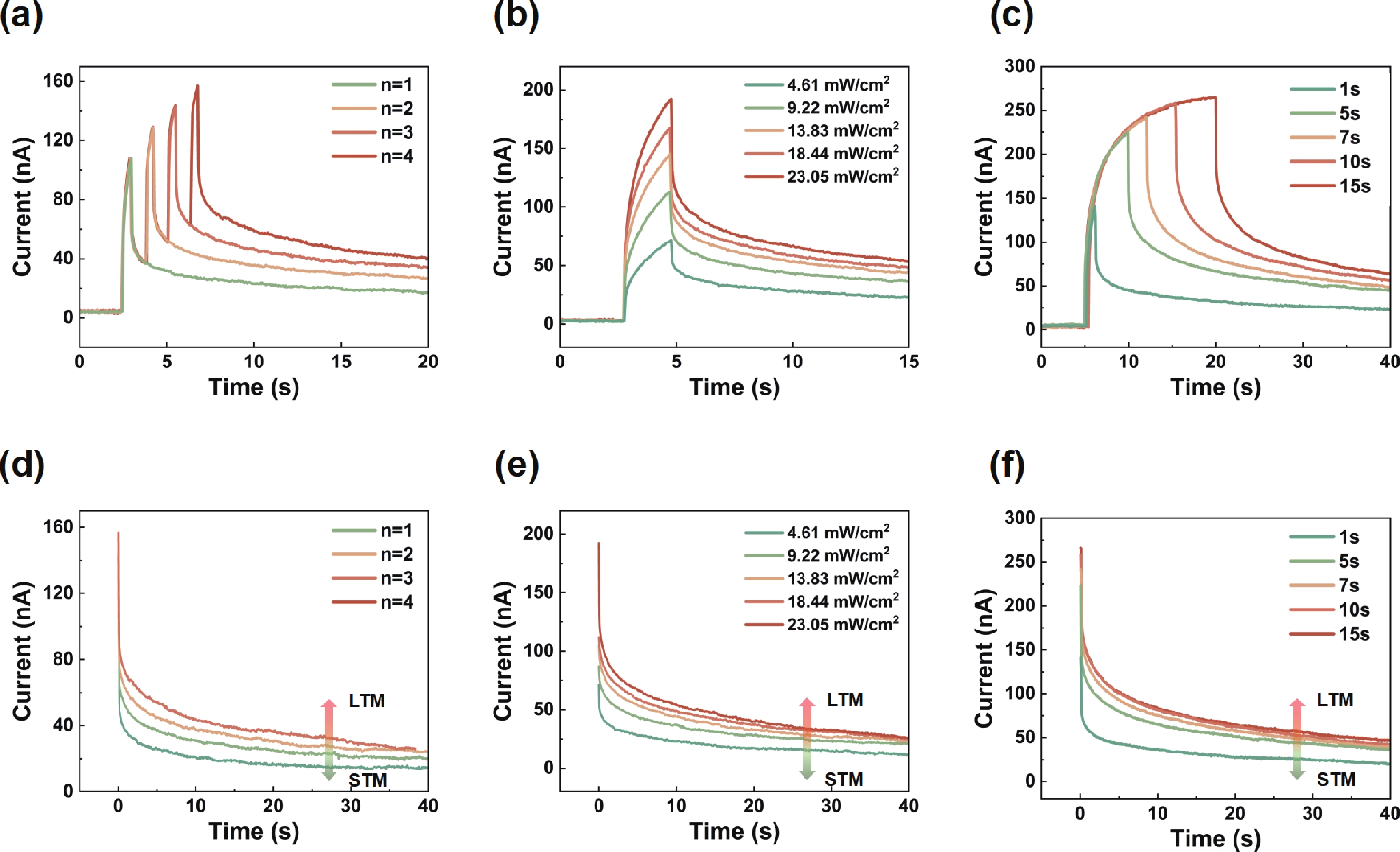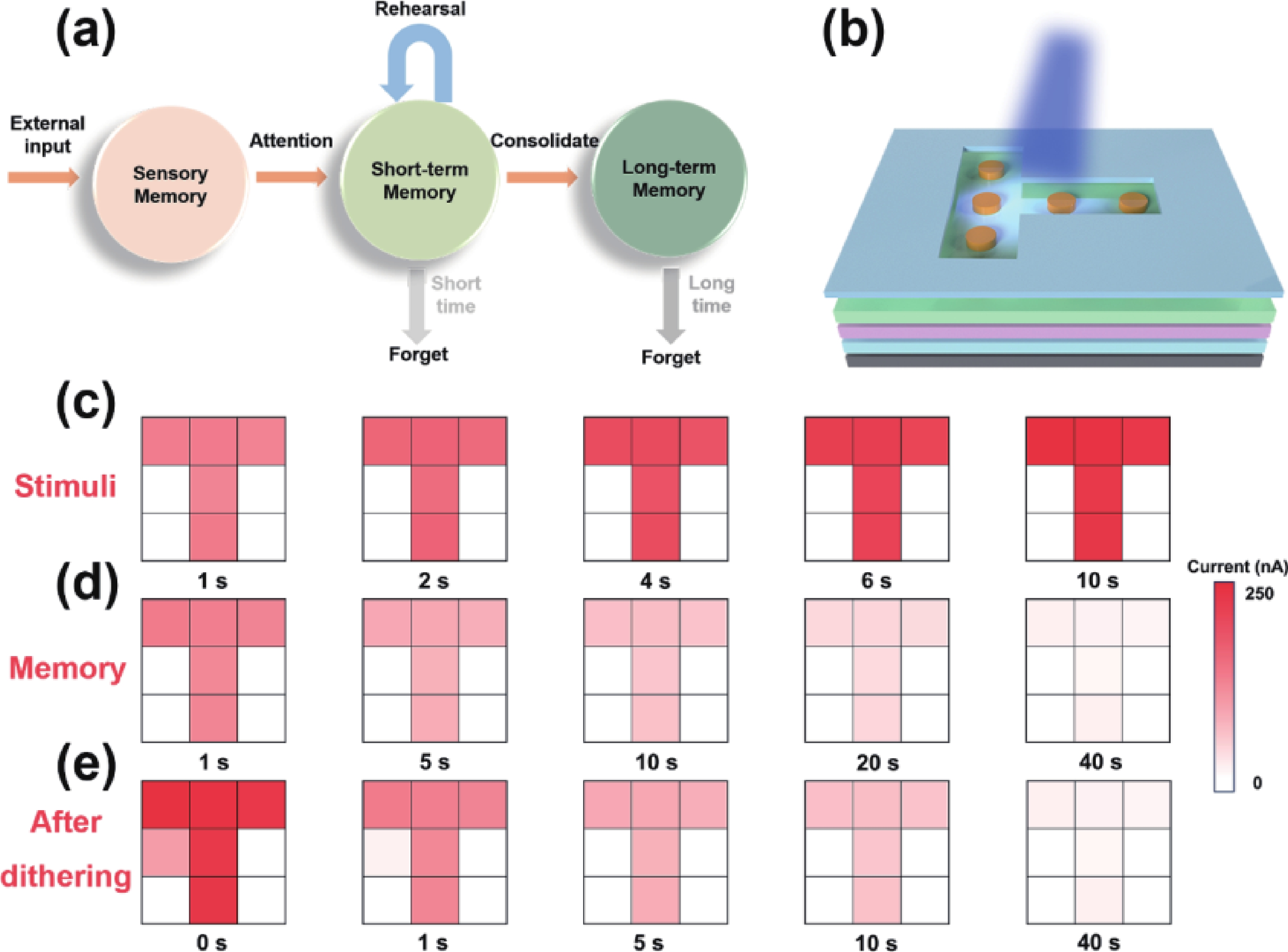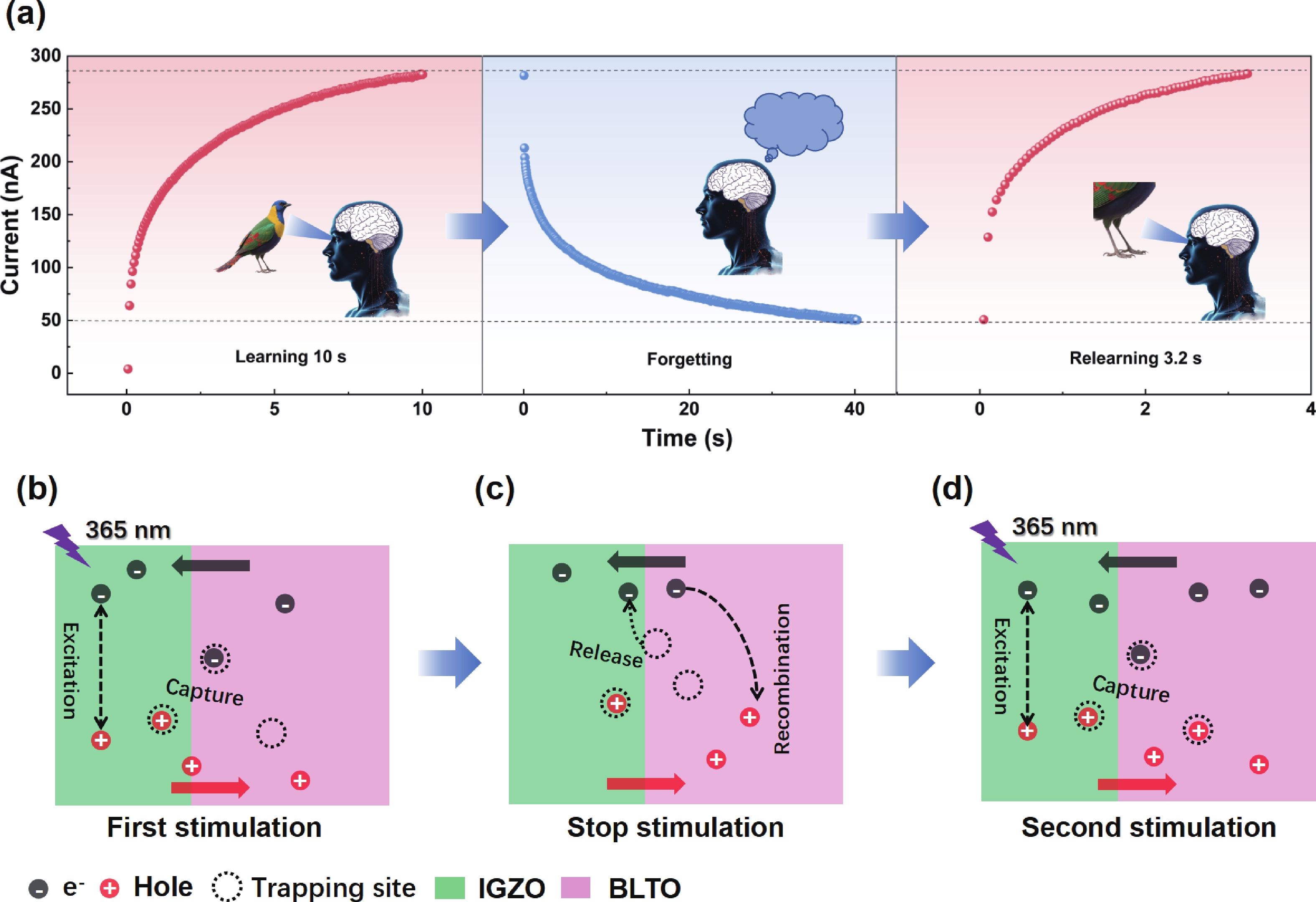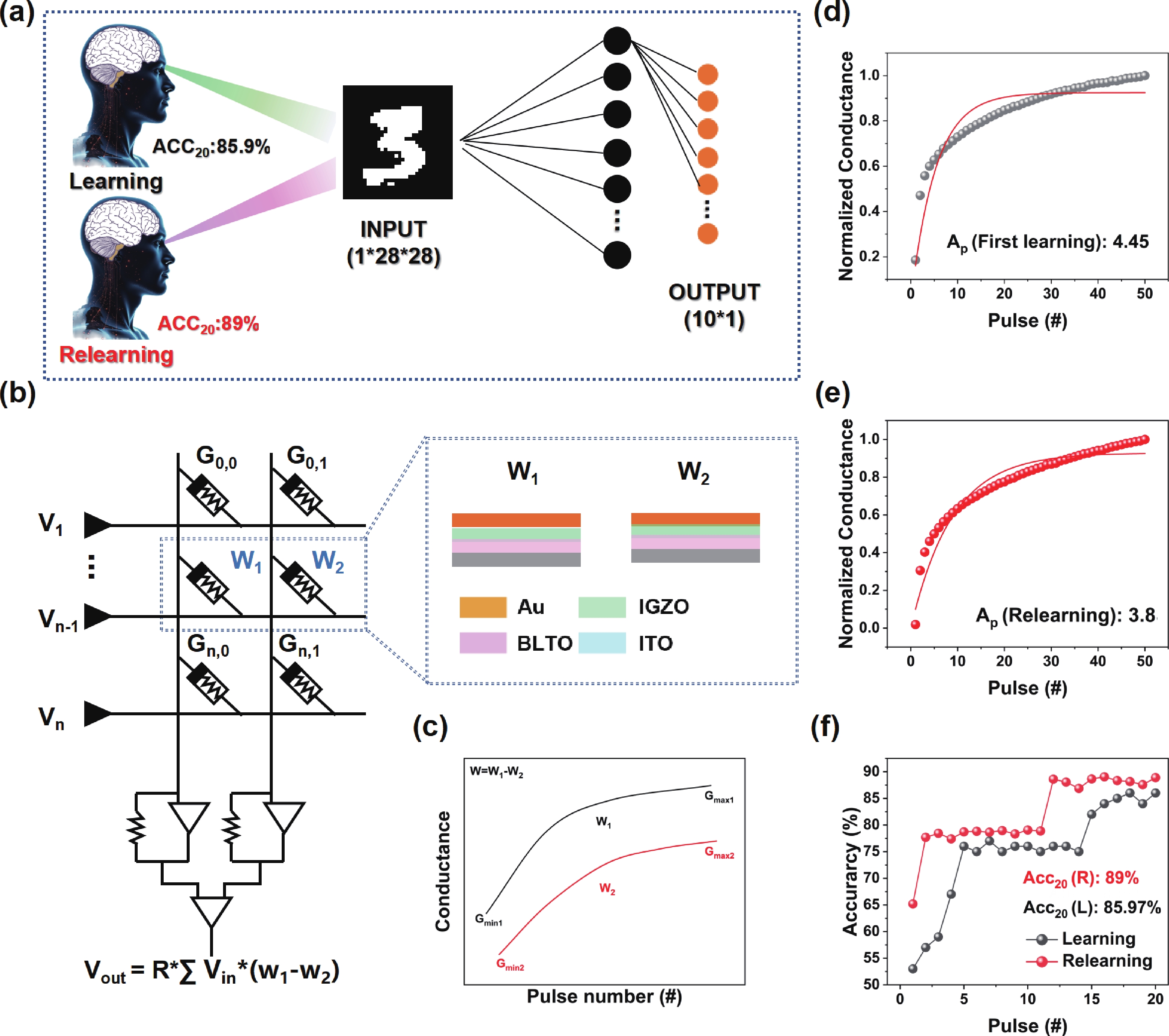| Citation: |
Dongping Yang, Hao Chen, Zhenhua Tang, Qijun Sun, Xingui Tang. Optoelectronic synapses based on IGZO/Bi3.25La0.75Ti3O12 heterojunctions for human brain learning mechanism simulation[J]. Journal of Semiconductors, 2025, In Press. doi: 10.1088/1674-4926/25060032
****
D P Yang, H Chen, Z H Tang, Q J Sun, and X G Tang, Optoelectronic synapses based on IGZO/Bi3.25La0.75Ti3O12 heterojunctions for human brain learning mechanism simulation[J]. J. Semicond., 2025, accepted doi: 10.1088/1674-4926/25060032
|
Optoelectronic synapses based on IGZO/Bi3.25La0.75Ti3O12 heterojunctions for human brain learning mechanism simulation
DOI: 10.1088/1674-4926/25060032
CSTR: 32376.14.1674-4926.25060032
More Information-
Abstract
In recent years, optoelectronic synapses have garnered significant attention in the field of neuromorphic computing due to their integration of optical sensing and synaptic functions. In this work, we propose an optoelectronic synapse based on IGZO/Bi3.25La0.75Ti3O12 heterojunction. Under UV light stimulation, this device can simulate a range of synaptic behaviors, including paired-pulse facilitation, spike-intensity-dependent plasticity, spike-number-dependent plasticity, spike-width-dependent plasticity, and the transition from short-term memory to long-term memory. The majority of perceptible information for humans is acquired through the visual system. The 3 × 3 retinal morphology synapse arrays constructed based on plasticity behaviors not only integrates light perception and storage functions but also exhibits adaptive adjustment capabilities to address image blurring caused by object movement. At the same time, in CNN recognition training, the device successfully simulates the learning-relearning mechanism of the human brain. These findings highlight the device’s immense potential for applications in artificial vision systems.-
Keywords:
- optoelectronic synapses,
- thin films,
- neural networks
-
References
[1] Feng C, Li B W, Dong Y, et al. Quantum imaging of the reconfigurable VO2 synaptic electronics for neuromorphic computing. Sci Adv, 2023, 9(40), eadg9376 doi: 10.1126/sciadv.adg9376[2] Liu Y B, Cai D, Zhao T C, et al. Monolayer MoS2 synaptic devices synergistically modulated by Na+ ions and sulfur vacancies for neuromorphic computing and pain perception stimulation. J Mater Sci Technol, 2023, 163, 121 doi: 10.1016/j.jmst.2023.04.025[3] Yuan S, Qiu B, Amina K, et al. Robust and low-power-consumption black phosphorus–graphene artificial synaptic devices. ACS Appl. Mater. Interfaces, 2022, 14(18), 21242[4] Yan X, Zhao J, Liu S, et al. Memristor with Ag-cluster-doped TiO2 films as artificial synapse for neuroinspired computing. Adv Funct Mater, 2018, 28(1), 1705320 doi: 10.1002/adfm.201705320[5] Li Z, Wang T, Meng J, et al. Flexible aluminum-doped hafnium oxide ferroelectric synapse devices for neuromorphic computing. Mater Horiz, 2023, 10(9), 3643 doi: 10.1039/D3MH00645J[6] Guo Z, Liu G, Sun Y, et al. High-performance neuromorphic computing and logic operation based on a self-assembled vertically aligned nanocomposite SrTiO3: MgO film memristor. ACS Nano, 2023, 17(21), 21518 doi: 10.1021/acsnano.3c06510[7] Zhang Y, Zhou R, Ruan S, et al. An efficient MSM UV photodetector with an ultra-low dark current enhanced by a back to back TiO2/PbTiO3 PN heterojunction. Appl Phys Lett, 2023, 123(13[8] Wu J, Ye W, Lin J, et al. Temperature regulated artificial neuron based on memristor. IEEE Electr Device L, 2022, 43(11), 2001 doi: 10.1109/LED.2022.3206796[9] Patil H, Rehman S, Kim H, et al. Effect of growth temperature on self-rectifying BaTiO3/ZnO heterojunction for high-density crossbar arrays and neuromorphic computing. J Colloid Interf Sci, 2023, 652, 836 doi: 10.1016/j.jcis.2023.08.105[10] Li Q, Wang T, Yang Y, et al. Artificial vision adaptation based on optoelectronic neuromorphic transistors. IEEE Electr Device L, 2022, 43(11), 1917 doi: 10.1109/LED.2022.3205315[11] Wang S, Chen H, Liu T, et al. Retina-inspired organic photonic synapses for selective detection of SWIR light. Angew Chem Int Edit, 2023, 62(6), e202213733 doi: 10.1002/anie.202213733[12] Gong Y, Xie P, Xing X, et al. Bioinspired artificial visual system based on 2D WSe2 synapse array. Adv Funct Mater, 2023, 33(41), 2303539 doi: 10.1002/adfm.202303539[13] Liu X, Wang F, Su J, et al. Bio-inspired 3D artificial neuromorphic circuits. Adv Funct Mater, 2022, 32(22), 2113050 doi: 10.1002/adfm.202113050[14] Fan S, Wu E, Cao M, et al. Flexible In–Ga–Zn–N–O synaptic transistors for ultralow-power neuromorphic computing and EEG-based brain–computer interfaces. Mater Horiz, 2023, 10(10), 4317 doi: 10.1039/D3MH00759F[15] Wang Y L, Cao M, Bian J, et al. Flexible ZnO nanosheet-based artificial synapses prepared by low-temperature process for high recognition accuracy neuromorphic computing. Adv Funct Mater, 2022, 32(52), 2209907 doi: 10.1002/adfm.202209907[16] Wu X, Shi S, Liang B, et al. Ultralow-power optoelectronic synaptic transistors based on polyzwitterion dielectrics for in-sensor reservoir computing. Sci Adv, 2024, 10(16), eadn4524 doi: 10.1126/sciadv.adn4524[17] Fang Y, Meng J, Li Q, et al. Two-terminal photoelectric dual modulation synaptic devices for face recognition. IEEE Electr Device L, 2022, 44(2), 241[18] Li R, Wang W, Li Y, et al. Multi-modulated optoelectronic memristor based on Ga2O3/MoS2 heterojunction for bionic synapses and artificial visual system. Nano Energy, 2023, 111, 108398 doi: 10.1016/j.nanoen.2023.108398[19] Zhang Y G, Zheng H W, Zhang J X, et al. Photovoltaic effects in Bi4Ti3O12 thin film prepared by a sol–gel method. Mater Lett, 2014, 125, 25 doi: 10.1016/j.matlet.2014.03.146[20] Casadio S, Gondolini A, Sangiorgi N, et al. Highly transparent Bi4Ti3O12 thin-film electrodes for ferroelectric-enhanced photoelectrochemical processes. Sustain Energ Fuels, 2023, 7(4), 1107 doi: 10.1039/D2SE01372J[21] Jiang Y P, Zhou H C, Tang X G, et al. Enhanced and controllable ferroelectric photovoltaic effects in Bi4Ti3O12/TiO2 composite films. J Electron Mater, 2023, 52(1), 188 doi: 10.1007/s11664-022-09960-6[22] Lu X, Wu X, Li L, et al. Switching properties of Nd-and La-doped Bi4Ti3O12 thin films under applied stress. Phys Rev B—Condens Matt and Mater Phys, 2005, 72(21), 212103 doi: 10.1103/PhysRevB.72.212103[23] Garg A, Hu X, Barber Z H. Structure and properties of lanthanide doped Bi4Ti3O12 films. Ferroelectrics, 2005, 328(1), 93 doi: 10.1080/00150190500311292[24] Le B Q, Van T N, Quang D T, et al. A simple and effective carrier lifetime characterization for semiconductor thin films. J Semicond, 2025, 46(7), 072101-1-072101-12 doi: 10.1088/1674-4926/24090005[25] Zhu Y, Mao H, Zhu Y, et al. Photoelectric synapse based on InGaZnO nanofibers for high precision neuromorphic computing. IEEE Elect Device L, 2022, 43(4), 651-654 doi: 10.1109/LED.2022.3149900[26] Yang Y, Cui H, Ke S, et al. Reservoir computing based on electric-double-layer coupled InGaZnO artificial synapse. Appl Phys Lett, 2023, 122(4[27] Wang Z Q, Xu H Y, Li X H, et al. Synaptic learning and memory functions achieved using oxygen ion migration/diffusion in an amorphous InGaZnO memristor. Adv Funct Mater, 2012, 22(13), 2759 doi: 10.1002/adfm.201103148[28] Ghafoor F, Kim H, Ghafoor B, et al. Interface engineering in ZnO/CdO hybrid nanocomposites to enhanced resistive switching memory for neuromorphic computing. J Colloid Interf Sci, 2024, 659, 1 doi: 10.1016/j.jcis.2023.12.084[29] Jiang S, Peng L, Li L, et al. Task-adaptive neuromorphic computing using reconfigurable organic neuristors with tunable plasticity and logic-in-memory operations. J Phys Chem Lett, 2024, 15(9), 2301 doi: 10.1021/acs.jpclett.4c00284[30] Zhou G, Li J, Song Q, et al. Full hardware implementation of neuromorphic visual system based on multimodal optoelectronic resistive memory arrays for versatile image processing. Nat Commun, 2023, 14(1), 8489 doi: 10.1038/s41467-023-43944-2[31] Wang Y, Lv Z, Chen J, et al. Photonic synapses based on inorganic perovskite quantum dots for neuromorphic computing. Adv mater, 2018, 30(38), 1802883 doi: 10.1002/adma.201802883[32] Ma H, Fang H, Xie X, et al. Optoelectronic synapses based on MXene/violet phosphorus van der waals heterojunctions for visual-olfactory crossmodal perception. Nano-Micro Lett, 2024, 16(1), 104 doi: 10.1007/s40820-024-01330-7[33] Chen L, Li R, Yuan S, et al. Fiber-shaped artificial optoelectronic synapses for wearable visual-memory systems. Matter, 2023, 6(3), 925 doi: 10.1016/j.matt.2022.12.001[34] Akbari M K, Ramachandran R K, Detavernier C, et al. Heterostructured plasmonic memristors with tunable opto-synaptic functionalities. J Mater Chem C, 2021, 9(7), 2539 doi: 10.1039/D0TC05563H[35] Liu S, Wu Z, He Z, et al. Low-power perovskite neuromorphic synapse with enhanced photon efficiency for directional motion perception. ACS Appl Mater Interfaces, 2024, 16(17), 22303 doi: 10.1021/acsami.4c04398[36] Wu T, Gao S, Li Y. IGZO/WO3− x-Heterostructured Artificial Optoelectronic Synaptic Devices Mimicking Image Segmentation and Motion Capture. Small, 2024, 20(27), 2309857 doi: 10.1002/smll.202309857[37] Li Q, Wang T, Fang Y, et al. Ultralow power wearable organic ferroelectric device for optoelectronic neuromorphic computing. Nano Lett, 2022, 22(15), 6435 doi: 10.1021/acs.nanolett.2c01768[38] Dong L, Yuan S, Wei G, et al. Artificial optoelectronic synapse based on violet phosphorus microfiber arrays. Small, 2024, 20(13), 2306998 doi: 10.1002/smll.202306998[39] Xu L, Wang W, Li Y, et al. N: ZnO/MoS2-heterostructured flexible synaptic devices enabling optoelectronic co-modulation for robust artificial visual systems. Nano Res, 2024, 17(3), 1902 doi: 10.1007/s12274-023-6004-4[40] Wan Z, Zhang Q, Hu F, et al. Topological insulator optoelectronic synapses for high-accuracy binary image recognition using recurrent neural networks. Adv Opt Mater, 2023, 11(2), 2201852 doi: 10.1002/adom.202201852[41] Liang J, Yu X, Qiu J, et al. All-optically controlled artificial synapses based on light-induced adsorption and desorption for neuromorphic vision. ACS Appl Mater Interfaces, 2023, 15(7), 9584 doi: 10.1021/acsami.2c20166[42] Yang L, Singh M, Shen S W, et al. Transparent and flexible inorganic perovskite photonic artificial synapses with dual-mode operation. Adv Funct Mater, 2021, 31(6), 2008259 doi: 10.1002/adfm.202008259[43] Yang D P, Li R H, Tang X G, et al. Photoelectric dual mode sensing system based on one-step fabricated heterojunction artificial synapses device. Mater Sci Eng R R, 2025, 165, 101021 doi: 10.1016/j.mser.2025.101021[44] Li D L, Tang X G, Zhong W M, et al. Photoelectric dual-mode and nonvolatile modulation based on ferroelectric memristors for reservoir computing. ACS Sustainable Chem & Eng, 2024, 12(35), 13361[45] Fang J, Tang Z, Lai X C, et al. New-style logic operation and neuromorphic computing enabled by optoelectronic artificial synapses in an MXene/Y: HfO2 ferroelectric memristor. ACS Appl Mater Interfaces, 2024, 16(24), 31348 doi: 10.1021/acsami.4c05316[46] Chen R, Jia X, Zhou H, et al. Applications of MXenes in wearable sensing: Advances, challenges, and prospects. Mater Today, 2024, 75, 359 doi: 10.1016/j.mattod.2024.04.013[47] Chen X, Chen B, Jiang B, et al. Nanowires for UV–vis–IR optoelectronic synaptic devices. Adv Funct Mater, 2023, 33(1), 2208807 doi: 10.1002/adfm.202208807[48] Chen K, Hu H, Song I, et al. Organic optoelectronic synapse based on photon-modulated electrochemical doping. Nat Photo, 2023, 17(7), 629 doi: 10.1038/s41566-023-01232-x[49] Wang Y, Zhu Y, Li Y, et al. Dual-modal optoelectronic synaptic devices with versatile synaptic plasticity. Adv Funct Mater, 2022, 32(1), 2107973 doi: 10.1002/adfm.202107973[50] Yang D P, Yan K, Li J, et al. Bifunctional optoelectronic devices based on Ruddlesden-Popper Sr2TiO4 for emulating neuromorphic attention mechanisms. Opt Laser Technol, 2025, 192, 113491 doi: 10.1016/j.optlastec.2025.113491 -
Supplements
 Surpporting_information.pdf
Surpporting_information.pdf

-
Proportional views





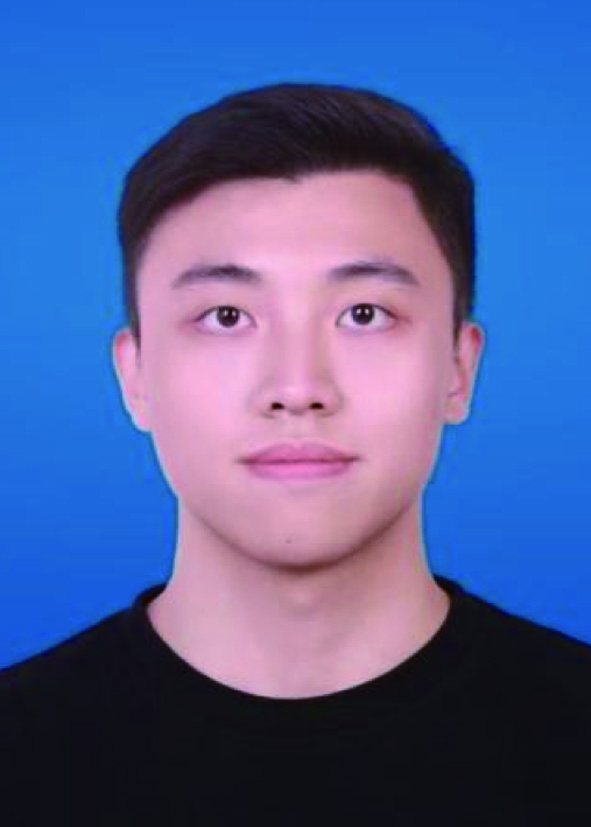 Dongping Yang Dong-Ping Yang received his M.S. degree in Electronic Information from Guangdong University of Technology (GDUT), China, in 2023 under the supervision of Prof. Miao He. He is currently pursuing a Ph.D. in Material Physics and Chemistry at GDUT, co-advised by Prof. Xin-Gui Tang and Prof. Qi-Jun Sun. His research focuses on the development of photoelectric synaptic devices for artificial neural network applications. He specializes in thin-film fabrication and characterization, optoelectronic pulse modulation techniques, and neural networkbased pattern recognition training. Dr. Yang has authored 3 first-author SCI papers (6 publications in total) on neuromorphic devices and artificial intelligence hardware systems. His current research interests include neuromorphic computing, brain-inspired intelligent systems, and the integration of optoelectronic materials with machine learning algorithms.
Dongping Yang Dong-Ping Yang received his M.S. degree in Electronic Information from Guangdong University of Technology (GDUT), China, in 2023 under the supervision of Prof. Miao He. He is currently pursuing a Ph.D. in Material Physics and Chemistry at GDUT, co-advised by Prof. Xin-Gui Tang and Prof. Qi-Jun Sun. His research focuses on the development of photoelectric synaptic devices for artificial neural network applications. He specializes in thin-film fabrication and characterization, optoelectronic pulse modulation techniques, and neural networkbased pattern recognition training. Dr. Yang has authored 3 first-author SCI papers (6 publications in total) on neuromorphic devices and artificial intelligence hardware systems. His current research interests include neuromorphic computing, brain-inspired intelligent systems, and the integration of optoelectronic materials with machine learning algorithms.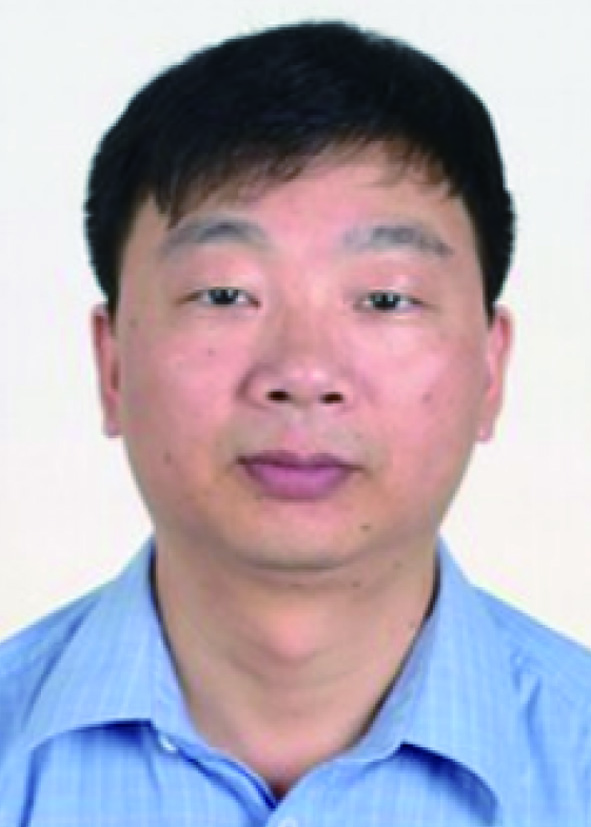 Xingui Tang Xin-Gui Tang, doctoral supervisor of Guangdong University of Technology, part-time doctoral supervisor of Xiangtan University. Director of Sol-Gel Branch of China Silicate Society. The academic leader of the doctoral program of " Material Physics and Chemistry " in the College of Physics and Optoelectronic Engineering, the academic leader of the provincial key advantageous discipline " Electronic Science and Technology, " and the provincial key training object of " Thousands of Projects " in Guangdong Province. For more than ten years, he has been engaged in the basic research work on the physical properties of ferroelectric thin films and ceramics.
Xingui Tang Xin-Gui Tang, doctoral supervisor of Guangdong University of Technology, part-time doctoral supervisor of Xiangtan University. Director of Sol-Gel Branch of China Silicate Society. The academic leader of the doctoral program of " Material Physics and Chemistry " in the College of Physics and Optoelectronic Engineering, the academic leader of the provincial key advantageous discipline " Electronic Science and Technology, " and the provincial key training object of " Thousands of Projects " in Guangdong Province. For more than ten years, he has been engaged in the basic research work on the physical properties of ferroelectric thin films and ceramics.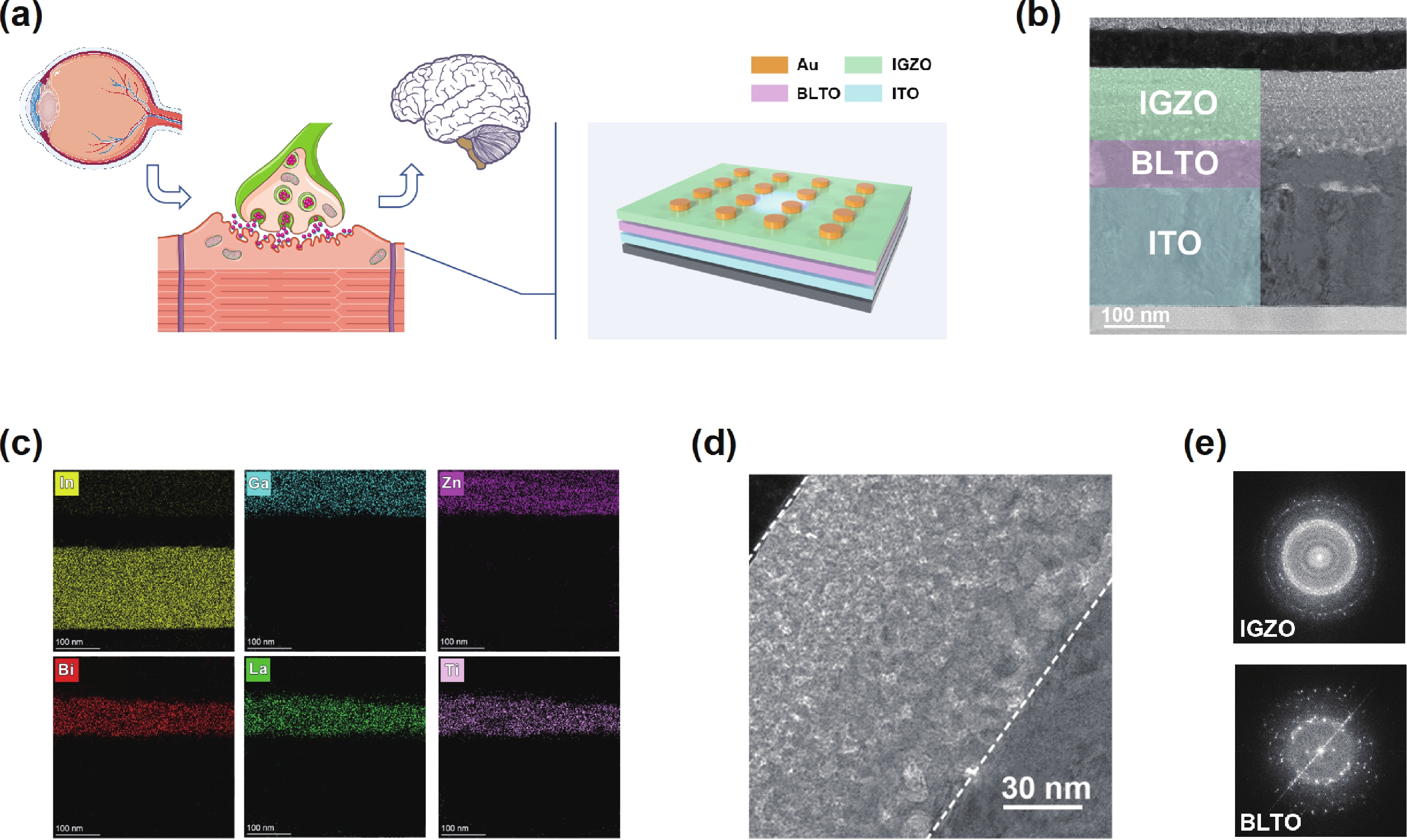
 DownLoad:
DownLoad:
